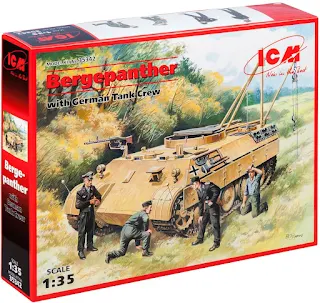Welcome back to the BergePanther model kit project. My first attempt on this Black and White Painting method has been, least to say interesting and quite rewarding. Writings by Mr. JOSE LUIS LOPEZ RUIZ, floats the idea of creating artificial light and shadows on an object, pretty much like drawings in Black and White, where pencil shadings are created over a white canvas, creating DEPTH.
It is the depth in real life, that allows our eyes to observe lines, colour and shades, in order to recongise objects and forms. In his book, depth is created using shades of grey between pure black and pure white. There are four shades of grey tone. However, this was a challange to prep four tones. Instead a whitish grey was made between pure black and white, with black primer remaining as the darkest shadow, pure white as the direct lighted objects and the whitish grey used on various surfaces to simulate the depth. Depth was created by several passes on certain areas to create more 'lighted' than others.
A summary of the results.
- At the Black and White application stages, various areas can be contrasted using shades orwhite and grey with white being the shade, the eyes observed an area in direct sunlight. Correspondingly, pure black is the dark shadows on an area (i.e. crevices between steel plates.) after grey shading, i 've use a fine paint brush to apply pure white areas which is most ideal. The effect really stands out.
- Paint to Air mixture has to be correct and paint must be thinned down enough. Vallejo's range of Model Air premixed paints have been useful in this case. Sold as ready to use in a bottle, it's easy to control the gray shades. Airbrush pressure can also be tone down as the pre-mix was well diluted.
- Applying two to three different colours as in a camoflauge can be challenging. Instead i created two monotone colours, one above and below the track line. (showing the vehicle was pull from the front in it's original German dark yellow colour , and re-purposed with a new green shade towards the end of 1945, using German Dark Green colour.)

Paint Chips
Rolled homogeneous armour (RHA) is a type of vehicle armour made of a single steel composition hot-rolled to improve its material characteristics, as opposed to layered or cemented armour. Its first common application was in tanks. After World War II, it began to fall out of use on main battle tanks and other armoured fighting vehicles intended to see front-line combat as new anti-tank weapon technologies were developed which were capable of relatively easily penetrating rolled homogeneous armour plating even of significant thickness. (Wikipedia)
Abrasion of any RHA or Steel surfaces ultimately results in rust. Therefore, apart from stainless steel. All steel used are usually cleaned, primed and painted to enhance longevity and strength of the steel. Hence, the use of steel as armour during world war II predominated. Aluminum armour only came about from 50s and 60s.
When painted surfaces wear due to abrasion. primer colour and steel colours are exposed. This can be done by the use of sponge dabbing on random areas of wear to create worn surfaces to show chipped areas.
Colours combination used are
Engine Deck and Engine " Chipped " simulating worn out surfaces.
OVERALL LOOK...... NICE, I say!
Once this was completed to satisfaction, i pin wash the the details to add further depth to the scale model.
Let's talk more about Artist Oils next time.
ALL PARTS AFTER CHIPPING and PIN-WASHED ready for Artist Oils






















